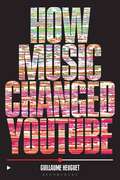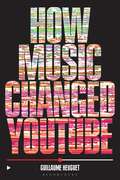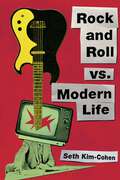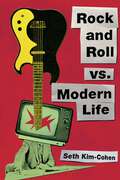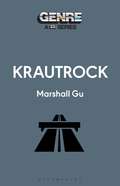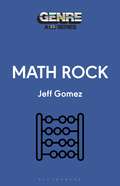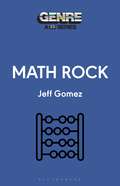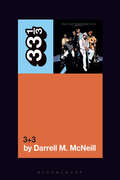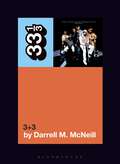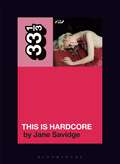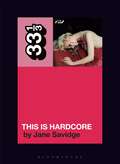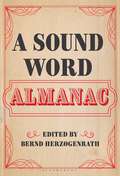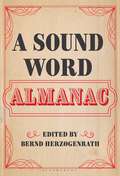- Table View
- List View
How Music Changed YouTube
by Dr. Guillaume HeuguetHow do digital technologies transform music? The answer depends on the lens of one's analysis: creation, promotion, or the experience of the listener. How Music Changed YouTube shows that the reverse question – How does music transform digital technologies? – is also worth exploring: through reliance on sound recording and music, internet technologies and media are manufactured, transformed, and come to dominate.Guillaume Heuguet's study situates YouTube in relation to both the internet platform and music industries by unpacking the cultural and technological forms embedded within and observing the practices and values associated with it, from the art of collecting to the accelerated circulation of samples and remixes. Heuguet's documentary and genealogical work relies on YouTube's traces in internet archives, its successive interfaces, the blogs of its teams, and a few emblematic channels and videos. Particular attention is paid to the tensions between the promises associated with music algorithms - recommendation system, copyright control, view calculation - and the reality of their operation from a technical and cultural point of view. How Music Changed YouTube shows how, far from responding to an immediate need, YouTube's editorial and economic model developed over time, how the various fans, artists, labels, lawyers and legislators shaped the site, and how these factors affected its rise as a global media force in the early 21st century.
How Music Changed YouTube
by Dr. Guillaume HeuguetHow do digital technologies transform music? The answer depends on the lens of one's analysis: creation, promotion, or the experience of the listener. How Music Changed YouTube shows that the reverse question – How does music transform digital technologies? – is also worth exploring: through reliance on sound recording and music, internet technologies and media are manufactured, transformed, and come to dominate.Guillaume Heuguet's study situates YouTube in relation to both the internet platform and music industries by unpacking the cultural and technological forms embedded within and observing the practices and values associated with it, from the art of collecting to the accelerated circulation of samples and remixes. Heuguet's documentary and genealogical work relies on YouTube's traces in internet archives, its successive interfaces, the blogs of its teams, and a few emblematic channels and videos. Particular attention is paid to the tensions between the promises associated with music algorithms - recommendation system, copyright control, view calculation - and the reality of their operation from a technical and cultural point of view. How Music Changed YouTube shows how, far from responding to an immediate need, YouTube's editorial and economic model developed over time, how the various fans, artists, labels, lawyers and legislators shaped the site, and how these factors affected its rise as a global media force in the early 21st century.
Rock and Roll Vs. Modern Life
by Seth Kim-CohenNo Boomer-esque celebration of the "music that defined an era," Rock and Roll vs. Modern Life is instead a deeply critical analysis of rock and roll as a chaotic, caterwauling project to upend the foundational presumptions of postwar values. What we have here is the closest thing yet to a unified field theory of rock and roll. In seminal performances, films, and recordings, Iggy Pop, James Brown, Patti Smith, the Last Poets, and the Sex Pistols disrupt the implicit ontologies of modernism and late-stage capitalism. With its comrades, conceptual art, Black power, and poststructuralism, rock and roll strips back the linoleum surface of modern life to reveal a feral sensibility unwilling to be boxed up for clean consumption.
Rock and Roll Vs. Modern Life
by Seth Kim-CohenNo Boomer-esque celebration of the "music that defined an era," Rock and Roll vs. Modern Life is instead a deeply critical analysis of rock and roll as a chaotic, caterwauling project to upend the foundational presumptions of postwar values. What we have here is the closest thing yet to a unified field theory of rock and roll. In seminal performances, films, and recordings, Iggy Pop, James Brown, Patti Smith, the Last Poets, and the Sex Pistols disrupt the implicit ontologies of modernism and late-stage capitalism. With its comrades, conceptual art, Black power, and poststructuralism, rock and roll strips back the linoleum surface of modern life to reveal a feral sensibility unwilling to be boxed up for clean consumption.
Krautrock (Genre: A 33 1/3 Series)
by Marshall GuKrautrock is not a music genre. Krautrock is a way of life. Its sonic diversity and global reach belie the common culture from where it emerged. This is a band-by-band history. In May 1945, the Allies defeated Nazi Germany, putting an end to the European front of World War II and the Third Reich. In the immediate aftermath, German youth were tasked to create their own culture. Krautrock is this unlikely success story, as hundreds of bands-including Kraftwerk and Can-seemed to sprout overnight in the early 1970s, forging a unique and experimental sound that was different than American or British rock. The major innovation of krautrock is not only its motorik beat, the steady click-click of Can's Jaki Liebezeit or monolithic stomp-stomp of Neu!'s Klaus Dinger, but also how the musicians relate to each other. In krautrock, no musician is given more focus than any other, and listening to these bands is to witness interplay common in jazz music. Thus, krautrock represents German politics reflected in music: a dictatorship replaced by democracy. Krautrock explores the history and methodology of the genre, charting its influences and innovations, its more mainstream acts (like Faust, Kraftwerk, and Can) as well as the less universally known (including Harmonia, Popol Vuh, Embryo, and Ash Ra Tempel), and how the genre developed in post-war Germany and what it means to today's listeners.
Krautrock (Genre: A 33 1/3 Series)
by Marshall GuKrautrock is not a music genre. Krautrock is a way of life. Its sonic diversity and global reach belie the common culture from where it emerged. This is a band-by-band history. In May 1945, the Allies defeated Nazi Germany, putting an end to the European front of World War II and the Third Reich. In the immediate aftermath, German youth were tasked to create their own culture. Krautrock is this unlikely success story, as hundreds of bands-including Kraftwerk and Can-seemed to sprout overnight in the early 1970s, forging a unique and experimental sound that was different than American or British rock. The major innovation of krautrock is not only its motorik beat, the steady click-click of Can's Jaki Liebezeit or monolithic stomp-stomp of Neu!'s Klaus Dinger, but also how the musicians relate to each other. In krautrock, no musician is given more focus than any other, and listening to these bands is to witness interplay common in jazz music. Thus, krautrock represents German politics reflected in music: a dictatorship replaced by democracy. Krautrock explores the history and methodology of the genre, charting its influences and innovations, its more mainstream acts (like Faust, Kraftwerk, and Can) as well as the less universally known (including Harmonia, Popol Vuh, Embryo, and Ash Ra Tempel), and how the genre developed in post-war Germany and what it means to today's listeners.
Neue Deutsche Welle (Genre: A 33 1/3 Series)
by Claudia LonkinNeue Deutsche Welle (NDW), or “German New Wave,” was made extraordinarily popular in the 1970s and 1980s by the likes of Nena's "99 Luftballoons" and Trio's "Da Da Da"-and then left as quickly as it came. Conventional wisdom among artists dictates that it's better to burn out than fade away, but this doesn't tell the full story of NDW-the reason for its rapid rise and fall, the historical context that necessitated the genre, and where the energy of the NDW movement went after its end. The genre has international influences but still demonstrates a uniquely German desire to build a new, sanitized identity in the aftermath of World War II. Originally quite subversive and underground, NDW became exponentially more mainstream until it could no longer sustain itself creatively. And rather than disappearing, it helped give rise to the post-Cold War rave craze and is still an important touchstone in music history.
Neue Deutsche Welle (Genre: A 33 1/3 Series)
by Claudia LonkinNeue Deutsche Welle (NDW), or “German New Wave,” was made extraordinarily popular in the 1970s and 1980s by the likes of Nena's "99 Luftballoons" and Trio's "Da Da Da"-and then left as quickly as it came. Conventional wisdom among artists dictates that it's better to burn out than fade away, but this doesn't tell the full story of NDW-the reason for its rapid rise and fall, the historical context that necessitated the genre, and where the energy of the NDW movement went after its end. The genre has international influences but still demonstrates a uniquely German desire to build a new, sanitized identity in the aftermath of World War II. Originally quite subversive and underground, NDW became exponentially more mainstream until it could no longer sustain itself creatively. And rather than disappearing, it helped give rise to the post-Cold War rave craze and is still an important touchstone in music history.
Math Rock (Genre: A 33 1/3 Series)
by Jeff GomezMath rock sounds like blueprints look: exact, precise, architectural. This trance-like progressive metal music with indie rock and jazz influences has been captivating and challenging listeners for decades. Bands associated with the genre include King Crimson, Black Flag, Don Caballero, Slint, American Football, Toe, Elephant Gym, Covet, and thousands more. In an online age of bedroom producers and sampled beats and loops, math rock is music that is absolutely and resolutely played: men and woman in rooms with instruments creating chaos, beauty, and beautiful chaos.This is the first book-length look at the global phenomenon. Containing interviews with prominent musicians, producers, and critics spanning the globe, Math Rock will delight longtime fans while also serving as a primer for those who want to delve deeper. It shows why and how an intellectually complex, largely faceless, and almost entirely instrumental form of music has been capturing the attention of listeners for 50 years-and counting.
Math Rock (Genre: A 33 1/3 Series)
by Jeff GomezMath rock sounds like blueprints look: exact, precise, architectural. This trance-like progressive metal music with indie rock and jazz influences has been captivating and challenging listeners for decades. Bands associated with the genre include King Crimson, Black Flag, Don Caballero, Slint, American Football, Toe, Elephant Gym, Covet, and thousands more. In an online age of bedroom producers and sampled beats and loops, math rock is music that is absolutely and resolutely played: men and woman in rooms with instruments creating chaos, beauty, and beautiful chaos.This is the first book-length look at the global phenomenon. Containing interviews with prominent musicians, producers, and critics spanning the globe, Math Rock will delight longtime fans while also serving as a primer for those who want to delve deeper. It shows why and how an intellectually complex, largely faceless, and almost entirely instrumental form of music has been capturing the attention of listeners for 50 years-and counting.
The Isley Brothers' 3+3 (33 1/3)
by Darrell M. McNeillThe Isley Brothers' 3+3, dissects The Isleys' 50-year-old undisputed masterwork, an album that firmly established their music dynasty on a global scale, as well as heralding the boldest run of genre-defiant albums of their 67-year career. The 1973 watershed was their first multiplatinum release and is significant as a rare, crossover record by a Black act that struck a chord with urban, rock, and pop consumers, despite the schisms between audiences due to bias-driven media and industry marketing.The book looks at the album from all angles: from The Isleys' early career to their influence on rock and rollers both Black and White, from the twists and turns of having national hits without national recognition, on to their decision to form T-Neck Records and the group's challenges navigating a music industry that racially codified music and hampered Black artists from universal acclaim and compensations. Finally, a summation of the decades follows The Isleys' run and its ups and downs, with a fast-forward to where the group is now after 67 years.
The Isley Brothers' 3+3 (33 1/3)
by Darrell M. McNeillThe Isley Brothers' 3+3, dissects The Isleys' 50-year-old undisputed masterwork, an album that firmly established their music dynasty on a global scale, as well as heralding the boldest run of genre-defiant albums of their 67-year career. The 1973 watershed was their first multiplatinum release and is significant as a rare, crossover record by a Black act that struck a chord with urban, rock, and pop consumers, despite the schisms between audiences due to bias-driven media and industry marketing.The book looks at the album from all angles: from The Isleys' early career to their influence on rock and rollers both Black and White, from the twists and turns of having national hits without national recognition, on to their decision to form T-Neck Records and the group's challenges navigating a music industry that racially codified music and hampered Black artists from universal acclaim and compensations. Finally, a summation of the decades follows The Isleys' run and its ups and downs, with a fast-forward to where the group is now after 67 years.
Pulp's This Is Hardcore (33 1/3)
by Jane SavidgeThis Is Hardcore is Pulp's cry for help. A giant, sprawling, flawed masterpiece of a record, the 1998 album manages to tackle some of the most inappropriate grown-up issues of the day – fame, ageing, mortality, drugs, and pornography – and still come out crying and laughing on the other side. The subject of pornography dominates the record – from its controversial artwork to the images conjured up by songs like "Seductive Barry" and the title track – after Pulp's main man, Jarvis Cocker – who'd spent most of his teenage and adult life chasing celebrity, only to be cruelly disappointed when it finally arrived in spades – hit upon the grand notion of using pornography as a metaphor for fame. The album's commercial failure as a follow-up to the band's Britpop-defining, Different Class, also symbolizes a death knell for Britpop itself. Dark, right? Except just like Pulp themselves, Jane Savidge's book is playful and sometimes very funny indeed. Kicking off with an imaginary conversation between Jarvis Cocker and the people who run the Total Fame Solutions helpline, Savidge expertly guides us through the trials and tribulations of an album that begins with the so-called Michael Jackson Incident, when Cocker got up on stage at the 1996 Brit Awards and waggled his fully-clothed bum at the King of Pop. Pulp's This Is Hardcore may be a sleazy run through porn and mental demise, and an album that chronicles Cocker's continuing disillusionment with his newfound lot in life, but Savidge's book assesses the cultural and historical context of the album with insider knowledge and a sharp modern lens, ultimately making a case for it as one of the most important albums of the 1990s.
Pulp's This Is Hardcore (33 1/3)
by Jane SavidgeThis Is Hardcore is Pulp's cry for help. A giant, sprawling, flawed masterpiece of a record, the 1998 album manages to tackle some of the most inappropriate grown-up issues of the day – fame, ageing, mortality, drugs, and pornography – and still come out crying and laughing on the other side. The subject of pornography dominates the record – from its controversial artwork to the images conjured up by songs like "Seductive Barry" and the title track – after Pulp's main man, Jarvis Cocker – who'd spent most of his teenage and adult life chasing celebrity, only to be cruelly disappointed when it finally arrived in spades – hit upon the grand notion of using pornography as a metaphor for fame. The album's commercial failure as a follow-up to the band's Britpop-defining, Different Class, also symbolizes a death knell for Britpop itself. Dark, right? Except just like Pulp themselves, Jane Savidge's book is playful and sometimes very funny indeed. Kicking off with an imaginary conversation between Jarvis Cocker and the people who run the Total Fame Solutions helpline, Savidge expertly guides us through the trials and tribulations of an album that begins with the so-called Michael Jackson Incident, when Cocker got up on stage at the 1996 Brit Awards and waggled his fully-clothed bum at the King of Pop. Pulp's This Is Hardcore may be a sleazy run through porn and mental demise, and an album that chronicles Cocker's continuing disillusionment with his newfound lot in life, but Savidge's book assesses the cultural and historical context of the album with insider knowledge and a sharp modern lens, ultimately making a case for it as one of the most important albums of the 1990s.
A Sound Word Almanac
by Bernd HerzogenrathThis almanac of sound words important to artists and scholars highlights words that expand the way we speak (and write) about sonic experiences.Why write about sound, and how? If sonic philosophy is the attempt "to think about sound by philosophical means," then a metaphilosophical debate appears almost immediately on the horizon: What is called for is an understanding about sound and language, but also about the preconditions of musical understanding. What is at stake is the question of language and sound, as well as expanding how we speak about sonic experience.This almanac tackles these questions from artistic, experimental and personal perspectives. An assemblage of nearly 70 practitioners and theoreticians, artists and scholars offer their favorite 'sound word.' These sound words are onomatopoetical, mythological, practical; words of personal importance to the artists and their craft; words from their memory, related to sound. Many entries are not in English – some are untranslatable – and all are accompanied by a personal, explanatory, poetic entry. These are words that have the potential to change our perspective on listening-musicking-thinking.
A Sound Word Almanac
This almanac of sound words important to artists and scholars highlights words that expand the way we speak (and write) about sonic experiences.Why write about sound, and how? If sonic philosophy is the attempt "to think about sound by philosophical means," then a metaphilosophical debate appears almost immediately on the horizon: What is called for is an understanding about sound and language, but also about the preconditions of musical understanding. What is at stake is the question of language and sound, as well as expanding how we speak about sonic experience.This almanac tackles these questions from artistic, experimental and personal perspectives. An assemblage of nearly 70 practitioners and theoreticians, artists and scholars offer their favorite 'sound word.' These sound words are onomatopoetical, mythological, practical; words of personal importance to the artists and their craft; words from their memory, related to sound. Many entries are not in English – some are untranslatable – and all are accompanied by a personal, explanatory, poetic entry. These are words that have the potential to change our perspective on listening-musicking-thinking.
